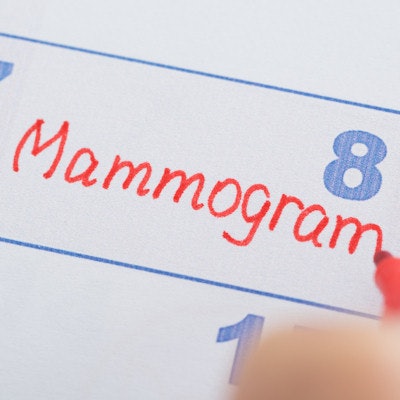
Mammography can be coordinated for use in hospitalized women who are overdue for screening and at high risk for developing breast cancer, according to research published July 4 in the American Journal of Preventive Medicine.
Researchers led by Dr. Waseem Khaliq from the Johns Hopkins University School of Medicine found that the combination of inpatient breast cancer screening education with inpatient screening mammography was successful in securing screening mammography for hospitalized women. They also found that more African American hospitalized women (86.2%) received an inpatient screening mammogram than white patients (75.4%).
"The finding is pertinent because women with poor access to health care are disproportionately from racial minorities and more likely to be diagnosed with late-stage cancers than their Caucasian counterparts," the study authors wrote.
About 40% of hospitalized women 50 to 75 years old are overdue or nonadherent to breast cancer screening guidelines, and nearly one-third of this group are also at high risk for developing breast cancer. Although breast cancer incidence is higher among white women, African American women have a higher mortality rate than white women, previous research suggests. In terms of screening mammography traditionally performed in outpatient settings, the most common barriers are transportation and remembering to schedule an appointment.
In their study, the researchers wanted to see if coordinating inpatient screening mammography for these women was feasible before their discharge from the hospital. The team looked at data from 101 insured, nonadherent women ages 50 to 74 who were hospitalized to a general medicine service, 29% of whom were African American.
Information such as sociodemographic background, reproductive history, family history of breast cancer, and medical comorbidities were collected from January 2015 to October 2016. The data were analyzed in March 2018.
Of the women, 22 were not able to receive inpatient screening mammography, though they agreed to having screening done. This was mainly because these women were either discharged from the hospital before the test, they changed their minds, or their clinical condition worsened during hospitalization, requiring transfer to a higher level of care.
The remaining 79 women underwent inpatient screening mammography, all of whom were "extremely satisfied" with the experience, the team said.
"The convenience of having screening mammography while hospitalized was reported to be a major facilitator of completing the overdue screening," the authors wrote.
The average time for the mammography procedure was 28 minutes, and the time needed to obtain finalized reports was 5 hours and 16 minutes. About 95% of women who underwent screening were given their mammography report before their discharge and had the results explained to them.
Of the 27 women requiring additional imaging, 17 received it during hospitalization, while the other 10 were referred and recommended to have an outpatient follow-up. No breast cancer cases were discovered among the initial screening exams. Follow-up testing was performed while patients were in the hospital.
All nurses taking care of these women reported that this practice should become part of the standard of care. About 66% of hospitalist physicians meanwhile agreed that this practice is feasible, according to the researchers.
"If this practice were adopted broadly, this would improve adherence to breast cancer screening guidelines, particularly in a cohort of patients at higher risk than in the general population," the authors wrote.
However, the team noted that it remains to be seen whether health insurance will cover the cost of such screening for patients in the hospital setting.
"As hospitals move toward assimilation into accountable care organizations with high functioning electronic medical records, tests needed for preventive care should be made available to patients wherever and whenever they interact with the healthcare system," the group said.




















